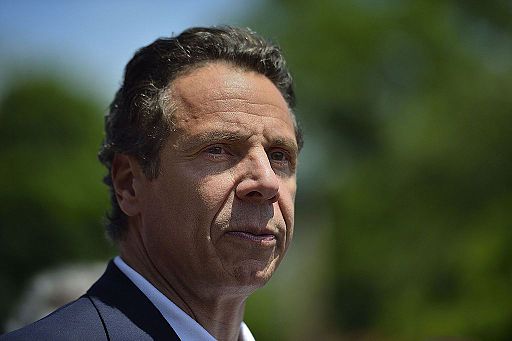Head-to-Head, Cuomo Leads Astorino by 30 Points; But By Only 15 Points In 3-Way Race with Liberal WFP Candidate
Most Voters Know Little About Moreland Commission; Overwhelmingly Side
with Fed Prosecutor Over Governor That Moreland Should Have Continued
Schneiderman & DiNapoli Each Unknown to More Than Half of Voters;
Only About One-Third Say they Are Prepared to Re-Elect Either One
Loudonville, NY. In a head-to-head matchup, Governor Andrew Cuomo continues to hold a better than two-to-one lead over Westchester County Executive Rob Astorino, 58-28 percent (down a little from 61-26 percent last month). However, if the race includes a Working Families Party candidate perceived to be more liberal or progressive than Cuomo, his lead falls to 15 points, with 39 percent for Cuomo, and 24 percent each for Astorino and the unnamed WFP candidate, according to a Siena College Poll of New York voters released today.
Although 84 percent of voters say corruption in Albany is a serious problem, less than one-third have followed the Moreland Commission closely and only one-quarter have heard or read at least some about the disbanding of the Commission. Nonetheless, by a 61-23 percent margin, voters side with a federal prosecutor that the Moreland Commission should have continued investigating state government corruption rather than the governor, who says that the new ethics law passed as part of the budget justifies disbanding the Moreland Commission.
Fewer than half the voters have an opinion about Attorney General Eric Schneiderman or State Comptroller Tom DiNapoli. Only about one-third of voters are prepared to re-elect either. A large majority of voters wants to see a coalition of Democrats and Republicans continue to control the State Senate next year.
“While Cuomo continues to hold a dominant position in a head-to-head matchup against Astorino, his lead is cut in half when a WFP candidate perceived to be more liberal or progressive than Cuomo is added to the mix,” said Siena College pollster Steven Greenberg. “More than 30 percent of Democrats, liberals, union households, New York City and black voters opt for a liberal WFP candidate. In a three-way race, independents are virtually evenly divided with 31 percent supporting Cuomo, 29 percent the WFP candidate and 27 percent Astorino.
“It’s been 24 years since a minor party candidate grabbed 20 percent of the gubernatorial vote, however, clearly facing opponents from both sides of the political spectrum would create a challenge for Cuomo,” Greenberg said.
Cuomo’s favorability rating is 57-38 percent (down from 58-34 percent last month) and his job performance is unchanged, 45-54 percent (46-54 percent last month). By a 50-41 percent margin voters say they are prepared to re-elect Cuomo compared to preferring ‘someone else’ (49-41 percent last month). Astorino has an 18-16 percent favorability rating, with 66 percent having no opinion (17-19-65 percent last month).
“Cuomo’s dilemma with a challenge from the left can be at least partly explained by the fact that Democrats see Cuomo as not liberal enough. More than twice as many Democrats describe Cuomo as moderate rather than liberal. By better than two-to-one, they want to see him be more of a liberal. By four-to-one, they see him as a pragmatic Democrat rather than a partisan Democrat. And by nearly two-to-one they say he’s favored business groups and their positions over labor unions and their positions,” Greenberg said.
Among all voters, 46 percent describe Cuomo as moderate, compared to 35 percent liberal and 11 percent conservative. They are evenly divided on whether he should be more of a liberal or more of a conservative. By a 59-29 percent margin, voters describe Cuomo as a pragmatic Democrat who works well with Republicans rather than a partisan Democrat who doesn’t work well with Republicans. And by a 41-27 percent margin, voters say Cuomo favors business and their views over unions and their views.
Most Voters Not Familiar with Moreland; Wish it Continued to Investigate Albany Corruption
Forty-one percent of voters say corruption in Albany is a very serious problem, with another 43 percent saying it’s somewhat serious. Yet, only 30 percent say they have followed news about the Moreland Commission even somewhat closely, while 37 percent say they have not followed it at all. Only 26 percent say they heard some about the disbanding of the Commission, while 41 percent heard nothing at all. By a 53-28 percent margin voters say the new laws represent a bad compromise rather than thinking it was the best that could be expected.
“While most voters did not follow the news about the Moreland Commission and the budget compromise that led to its disbanding, the vast majority of voters think that corruption in state government is a serious problem. A strong majority – including 66 percent who heard at least some about the disbanding of the Commission – feel that the budget resolution was a bad compromise that didn’t do enough to end corruption,” Greenberg said.
“When asked whether they agree more with a federal prosecutor, who says the Commission should have been allowed to continue investigating corruption, or the governor, who says the new laws justify disbanding the Commission, voters overwhelmingly side with the prosecutor,” Greenberg said. “At least 55 percent from every party and region side with the prosecutor, including 73 percent who heard some about the Moreland disbanding.
“The word Moreland no longer poses an investigative threat to legislators or others in state government,” Greenberg said. “The question now is will it pose a political threat to the governor?”
State Comptroller & Attorney General: Unknown to Majority of Voters. Re-election Vulnerability?
Schneiderman is viewed favorably by 27 percent and unfavorably by 20 percent, with 53 percent having no opinion (virtually unchanged from 27-19-55 percent in February). Currently, 35 percent of voters say they are prepared to re-elect him with 32 percent preferring ‘someone else (up a little from 29-33 percent in January). DiNapoli has 29-17-54 percent favorability rating (up a little from 26-21-54 percent in February). His re-elect rating is 32-35 percent (down a little from 35-30 percent in January).
“In this year’s down ballot races, the incumbents remain unknown or little known to most voters despite DiNapoli having served for more than seven years and Schneiderman more than three,” Greenberg said. “With six months until Election Day, voters are not enthusiastic about re-electing either one. However, with both having no publicly identified opponent, it’s still too early to say either is electorally vulnerable. Potentially vulnerable? For sure.”
Continued Bi-Partisan Control of State Senate in 2015 is Strongly Supported
“Only 16 percent of voters want to see the Republicans control the State Senate in 2015 after this year’s elections. Another 22 percent want the Democrats in control. However, a strong majority, 58 percent, want to see a coalition of Republicans and Democrats – like exists today – control the Senate next year,” Greenberg said. “That includes 64 percent of independents and 56 percent of both Democrats and Republicans, as well as a majority of voters from every region of the state.”
New Yorkers More Familiar with Common Core; Less Confident It Will Better Prepare Students
Seventy-three percent of voters say they are at least somewhat familiar with the Common Core learning standards, up from 61 percent in February. A plurality of voters, 37 percent, continues to say they are too demanding, with 23 percent each saying they are just right or not demanding enough. While 38 percent say they are confident Common Core will better prepare students for college and careers, 55 percent say they are not confident. In February, confidence was virtually even with 46 percent confident and 47 percent not confident.
“Given the extensive public debate about education and the Common Core over the last several months, more New Yorkers are familiar with the Common Core. However, that familiarity has decreased confidence among voters that the Common Core will better prepare students upon graduation. A strong majority from outside of New York City is either not very or not at all confident that the new learning standards will make graduates better prepared,” Greenberg said. “Also, only 26 percent think all that’s gone on over the last three years to improve the quality of public education has moved schools in the right direction, compared to 28 percent who say those efforts have moved schools in the wrong direction, and a plurality, 43 percent, who say there’s been little impact.”
This Siena College Poll was conducted April 12-17, 2014 by telephone calls to 772 New York State registered voters. It has an overall margin of error of + 3.5 percentage points. Data was statistically adjusted by age, party, region and gender to ensure representativeness. Sampling was conducted via random digit dialing to landline and cell phones weighted to reflect known population patterns. The Siena College Research Institute, directed by Donald Levy, Ph.D., conducts political, economic, social and cultural research primarily in New York State. SRI, an independent, non-partisan research institute, subscribes to the American Association of Public Opinion Research Code of Professional Ethics and Practices. For more information, call Steve Greenberg at (518) 469-9858. For survey cross-tabs: www.Siena.edu/SRI/SNY.





